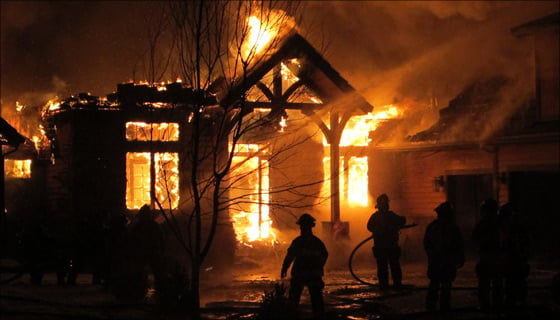
The recent wildfires devastating California represent the constant threat this peril poses, especially in California and other drought-ridden states. For homeowners and communities, these events underscore the urgent need to take proactive steps.
Wildfire and insurance experts recommend you:
- Know Your Risk – Understand your property’s vulnerability to wildfire as the first step. Tools like FreeHomeRisk.com can help determine your wildfire risk score, providing valuable insights to guide your mitigation efforts.
- Engage with Local Resources – Connect with your local fire departments and community wildfire mitigation resources to stay informed, prepare, and collaborate on reducing local risks.
- Take Action – Implement home hardening and wildfire mitigation measures, like those below, to help protect your family, your property, and your neighborhood.
Wildfire Mitigation and Home Hardening Measures
While no single measure can fully guarantee protection from wildfire, upgrading to fire-resistant materials and creating defensible space can significantly reduce your home’s risk of damage. According to Guidewire HazardHub, implementing even basic wildfire mitigation measures can cut the risk by 20%, while comprehensive strategies can reduce it by up to 74%."
A Guidewire HazardHub study highlights key measures that homeowners can adopt to enhance their property’s resilience. These strategies fall into two main categories: home hardening (fire-resistant building materials) and defensible space.
Home Hardening (Fire-Resistant Building Materials)
Building materials significantly influence your home’s ability to withstand a wildfire, but you don’t have to replace your walls and your roof to improve your property’s chance of survival. There are also DIY projects that reduce the risk of wildfire damage. The following upgrades are key:
Installing Fire-Resistant Roofing, Siding, and Windows
Your roof is one of the most vulnerable areas during a wildfire because wind-borne embers can ignite combustible materials. Upgrading to fire-resistant materials, such as metal, clay tiles, or asphalt shingles rated Class A for fire resistance, can make a substantial difference. Similarly, siding made from fiber cement, stucco, or metal can protect the exterior walls of your home. Double-pane or tempered-glass windows can prevent heat and embers from penetrating your home.
Using Non-Combustible Materials for Decks and Patios
Wooden decks and patios can act as fuel for wildfires. Replacing these structures with materials like concrete, metal, or stone can minimize the risk of ignition. If replacing them is not feasible, ensure wooden decks are sealed and regularly maintained to reduce flammability. The space beneath the deck should be debris-free and enclosed.
Enclosed Eaves
Open eaves are vulnerable to wind-driven embers, which can swirl beneath the eaves and ignite the walls or attic once radiant heat reaches the ignition point. Enclosing eaves with fire-resistant materials can protect the structure by preventing embers from entering through vents or windows.
Screened Vents
Unless properly screened, embers can easily enter your home through vents, making them a critical point of vulnerability. Installing metal mesh screens with openings no larger than 1/8 inch can help block embers while still allowing for proper ventilation.
Non-Combustible Attachments
Wooden fences, patio covers, leaf gutters, and other attachments connected to your home can act as bridges for fire to spread. Replacing these with metal or other non-combustible materials can reduce the risk of fire reaching your home.
Keeping Roofs and Gutters Free of Debris
Dry leaves and twigs in gutters or on the roof can easily catch fire, spreading flames quickly to your home. Regularly clearing these areas can reduce ignition risk and help protect your property.
Defensible Space
Defensible space is the buffer you create between your home and surrounding vegetation or combustible structures. This buffer can help slow the spread of wildfire and provides firefighters with a safer environment to defend your property.
Keeping Propane Tanks at Least 15 Feet from Any Significant Fuel Source
Keeping vegetation away from a propane tank and ensuring it is at least 15 feet from combustible structures help prevent explosions. Placing the tank at least 30 feet away further reduces the risk of structural damage if nearby vegetation burns for an extended period.
Ensuring Separate Structures Are at Least 30 Feet from the Main Building
Structures like sheds or detached garages can become fuel for a fire. The International Residential Code (IRC) addresses fire separation distances between buildings to prevent the spread of fire. And while specific requirements can vary based on local amendments, keeping them at least 30 feet away from your main home and ensuring they are constructed with fire-resistant materials can help prevent fire from spreading.
The Importance of Multiple Measures
Adopting one or two mitigation measures is a great start, but wildfire risk is best reduced through a comprehensive approach. As the Guidewire HazardHub study illustrates, risk levels improve quickly as the number of mitigation actions increase, achieving significant protection only after multiple actions.
The Guidewire HazardHub study evaluated the effectiveness of wildfire mitigation measures using a resiliency scoring system based on the presence and quality of these actions—such as fire-resistant roofing, defensible space, and screened vents. Homes that scored eight or more points in the study’s resiliency scoring system experienced 30% lower damage ratios, while those with a score of 13 reduced expected losses by over 70%.
It may help to think of your home as a ship preparing for a stormy sea with holes along the bottom: plugging one leak won’t be enough to keep you afloat. To truly safeguard your home, you must address every vulnerability, from the roof to the ground.
No single measure or combination of measures can completely eliminate wildfire risk, but combining personal home-hardening strategies with community-wide initiatives strengthens resilience making post-event recovery less difficult.
Guidewire HazardHub insights, risk models, and scores help homeowners, insurers, and communities better understand wildfire risk and make more informed decisions.
Available across the U.S., Canada, and 19 other countries, HazardHub’s risk models empower insurers to enhance risk assessment and underwriting accuracy. HazardHub’s detailed risk insights are available through Guidewire’s PolicyCenter, InsuranceNow, and the HazardHub API. Consumers can also evaluate their home's risk at FreeHomeRisk.com.